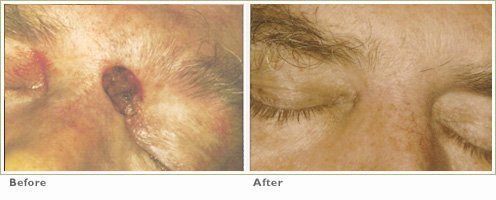Skin Cancer Treatments
About Photodynamic Therapy
Acne and rosacea can now be treated by PhotoDynamic Therapy with impressive results. With the ever-growing incidence of antibiotic-resistant bacteria, novel approaches to treating acne and rosacea have been approved which may limit the need for oral antibiotics and topical medications.
Benefits
- Reduces acne
- Reduces rosacea
- Reduces rhinophyma (enlarged nose from rosacea)
- Reduces sebaceous gland hyperplasia
- Reduces or eliminates use of oral antibiotics
- Eliminates concerns of antibiotic-resistant bacteria
- Effective
- No down time
- Minimal risk
Alternatives
Acne Laser Treatment, Acne Surgery, Chemical Peels, Clinical Facial, Medications (Antibiotics, Topical, Accutane), and Microdermabrasion.
How Does it Work?
Photodynamic therapy (PDT) for the treatment of acne and other skin diseases involves the use of photochemical reactions to photosensitizing agents, light, and oxygen. PDT involves two steps. First, the photo-sensitizer, Amino-Levulinic acid, is applied to the skin surface and taken up by the acne lesions. Then a specific wavelength of blue light is directed toward the acne lesions, activating the photo-sensitizer in the presence of oxygen. Because the photo-sensitizer is preferentially absorbed by the acne lesions and the light source is directly targeted on the lesional tissue, PDT achieves dual selectivity, minimizing damage to adjacent healthy structures. PDT is mediated by oxygen-dependent photochemical reactions, resulting in destruction of the acne lesion. The purpose of lasers in PDT is to initiate photochemical reactions, and not to heat or mechanically change tissue as seen in other dermatologic uses.
For acne in a large area encompassing the face, back or chest, non-coherent light sources such as the Blu-U light or Quantum IPL device are superior to laser systems because of their large illumination fields. Interestingly, given the right dose of drug and light, such non-coherent light sources appear to be as effective as laser sources.
Who is a Candidate?
Anyone who is not sensitive to light and levulinic acid may consider these treatments.
What can I Expect?
Reduction of acne, rosacea and sebaceous glands.
Results may vary.
Safety & Side Effects
These treatments are considered very safe. A thorough evaluation by your medical provider is necessary. The specific risks and the suitability of these procedures for a given individual can be determined only at the time of consultation. All procedures have some degree of risk. Minor complications that do not affect the outcome occur occasionally.
Recovery Time
Most patients have no irritation to the skin, though some will note a mild sunburn-like reaction which fades in a few days.
Does it Hurt?
This is usually a painless procedure.
Before Treatment Instructions
Avoid excessive sunlight for three days before procedure.
After Treatment Instructions
Avoid excessive sunlight for 3 days after procedure. Avoid excessively drying topical medications for 3 days after the procedure.
Who Performs the Treatments?
Our Physicians, Physician Assistants and Registered Nurses.
Photodynamic Therapy Gallery
Photodynamic Therapy for Precancers/Actinic Keratoses
*Results may vary.





